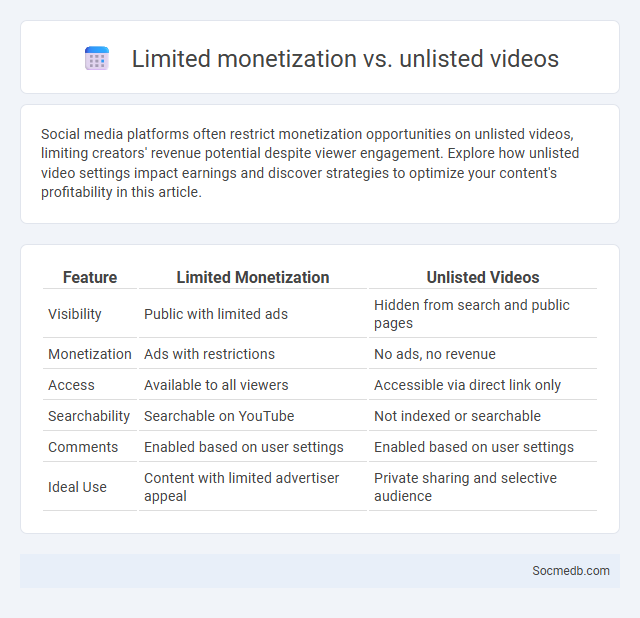
Photo illustration: Limited monetization vs Unlisted videos
Social media platforms often restrict monetization opportunities on unlisted videos, limiting creators' revenue potential despite viewer engagement. Explore how unlisted video settings impact earnings and discover strategies to optimize your content's profitability in this article.
Table of Comparison
| Feature | Limited Monetization | Unlisted Videos |
|---|---|---|
| Visibility | Public with limited ads | Hidden from search and public pages |
| Monetization | Ads with restrictions | No ads, no revenue |
| Access | Available to all viewers | Accessible via direct link only |
| Searchability | Searchable on YouTube | Not indexed or searchable |
| Comments | Enabled based on user settings | Enabled based on user settings |
| Ideal Use | Content with limited advertiser appeal | Private sharing and selective audience |
Understanding YouTube’s Video Monetization Options
YouTube offers multiple video monetization options including AdSense ads, channel memberships, Super Chat, and merchandise shelf integration, each designed to maximize creator revenue based on engagement and content type. Understanding YouTube Partner Program eligibility and advertiser-friendly guidelines is crucial for enabling monetization features and optimizing earnings. Leveraging analytics tools helps creators identify top-performing videos and customize monetization strategies to boost viewer interaction and revenue streams.
What is Limited Monetization?
Limited Monetization on social media refers to restrictions placed on content that reduces its ability to generate revenue through ads due to violations of platform policies or advertiser guidelines. Content flagged under Limited Monetization may still be viewable but will earn reduced or no ad revenue, impacting creators' income. This status often results from sensitive topics, inappropriate language, or controversial issues that platforms deem unsuitable for broad advertising.
Defining Unlisted Videos on YouTube
Unlisted videos on YouTube are content that only users with the direct link can view, preventing these videos from appearing in public search results or channel listings. This feature allows creators to share videos selectively without making them fully private or public. Unlisted videos are ideal for limited audience engagement, such as private group sharing, exclusive content distribution, or testing.
Limited Monetization vs Unlisted Videos: Key Differences
Limited monetization on social media restricts creators from earning revenue due to content that violates platform guidelines, while unlisted videos remain hidden from public search and feeds but are accessible via direct links. Monetization status affects ad revenue eligibility, whereas unlisted status controls video visibility without impacting monetization. Platforms like YouTube and Facebook implement these features to balance content control with creator earnings.
Eligibility Criteria for Limited Monetization
To qualify for limited monetization on social media platforms, your account must meet specific eligibility criteria including a minimum follower count, compliance with community guidelines, and sustained content originality. Your videos should demonstrate consistent engagement metrics such as watch time and viewer interaction to maintain eligibility. Adhering to platform policies ensures your content remains monetizable under limited terms.
Pros and Cons of Limited Monetization
Limited monetization on social media platforms restricts your ability to generate consistent revenue, often resulting in lower financial rewards despite high engagement rates. However, this limitation can encourage creators to focus more on authentic content and community building rather than purely commercial goals. Navigating these pros and cons helps you balance creative freedom with financial sustainability in the evolving digital landscape.
Monetization Challenges with Unlisted Videos
Monetization challenges with unlisted videos on social media platforms often stem from restricted visibility, limiting ad revenue potential and viewer engagement. You may face difficulties qualifying for partner programs, as algorithms prioritize public content for monetization opportunities. Ensuring your unlisted videos comply with platform policies while exploring alternative revenue streams is essential for maximizing your earnings.
Impact on Revenue: Limited Monetization vs Unlisted Videos
Social media platforms offer varied monetization options, with unlisted videos providing limited direct revenue compared to fully monetized public content. You can leverage unlisted videos to target niche audiences or conduct private promotions, though these typically generate less income due to restricted visibility and ad placements. Optimizing your content strategy to balance public and unlisted videos helps maximize overall revenue potential on social media.
Best Practices for Maximizing Video Earnings
Implementing clear video monetization strategies such as leveraging ad placements, sponsored content, and affiliate marketing significantly increases revenue potential on social media platforms. Optimizing video length, engaging thumbnails, and compelling call-to-actions enhance viewer retention and click-through rates, directly impacting earnings. Regularly analyzing audience demographics and engagement metrics allows creators to tailor content for maximum monetization efficiency and platform-specific algorithm benefits.
Choosing the Right Upload Setting for Your Content
Selecting the ideal upload settings for your social media content ensures optimal quality and engagement across platforms like Instagram, Facebook, and TikTok. High-resolution images should be compressed without losing clarity to meet platform-specific requirements, while video uploads benefit from choosing the correct format, bitrate, and aspect ratio tailored to your audience's device preferences. By customizing these upload settings, you maximize your content's impact and enhance Your brand's professional appearance online.
 socmedb.com
socmedb.com